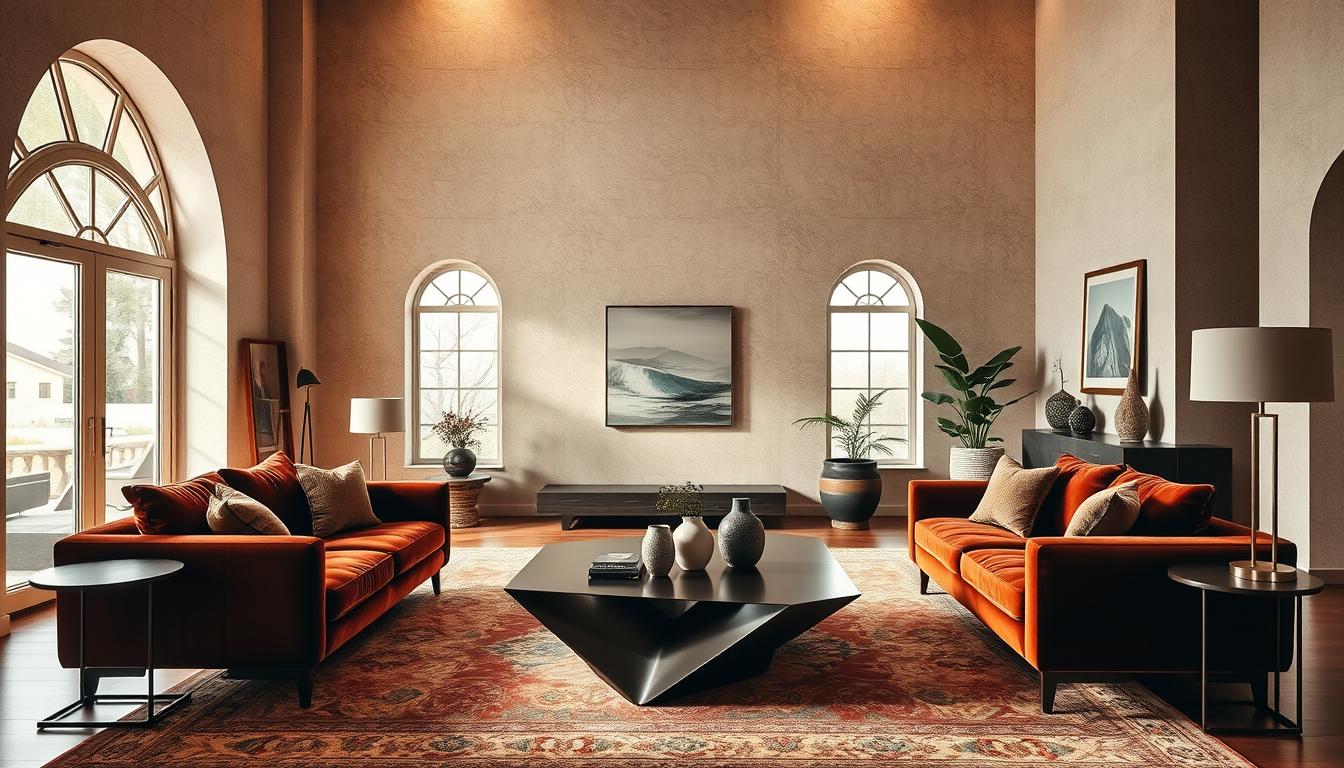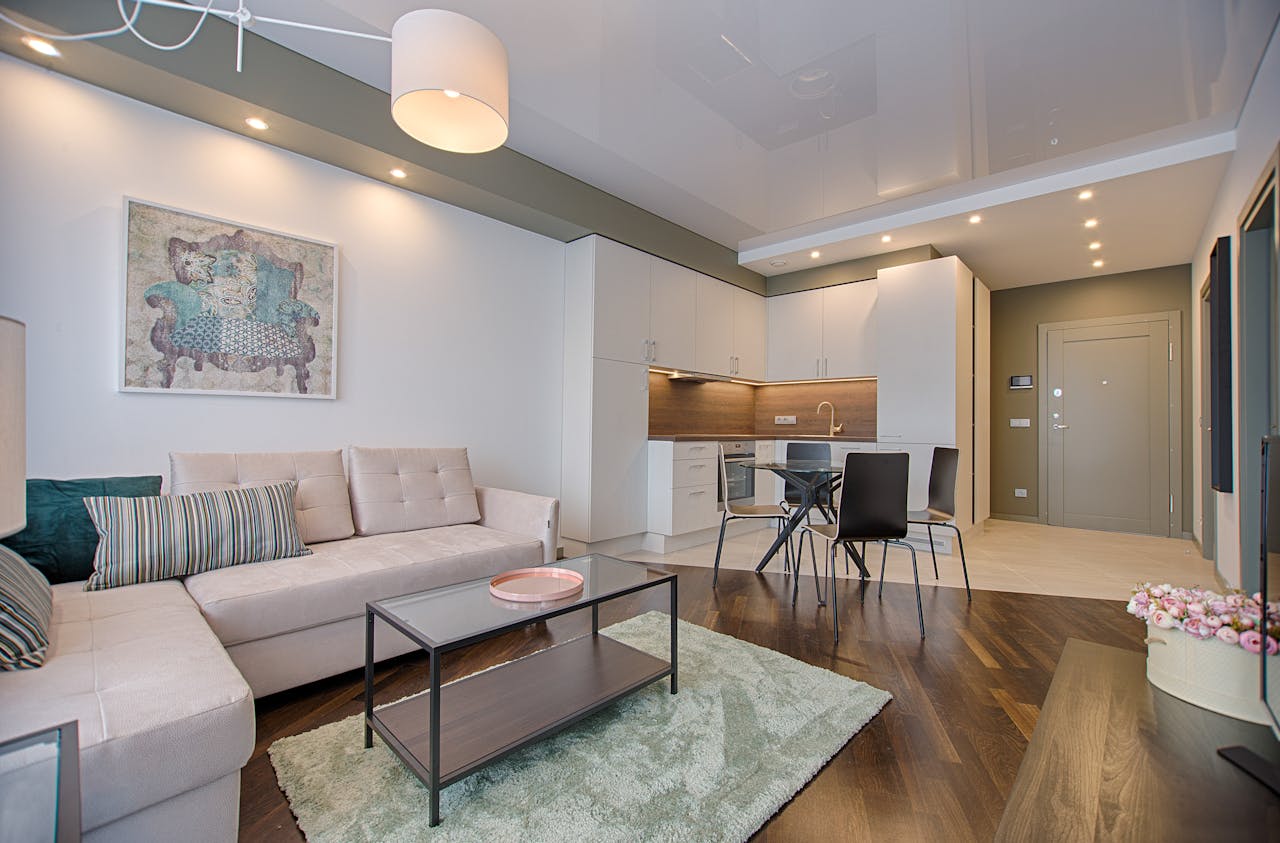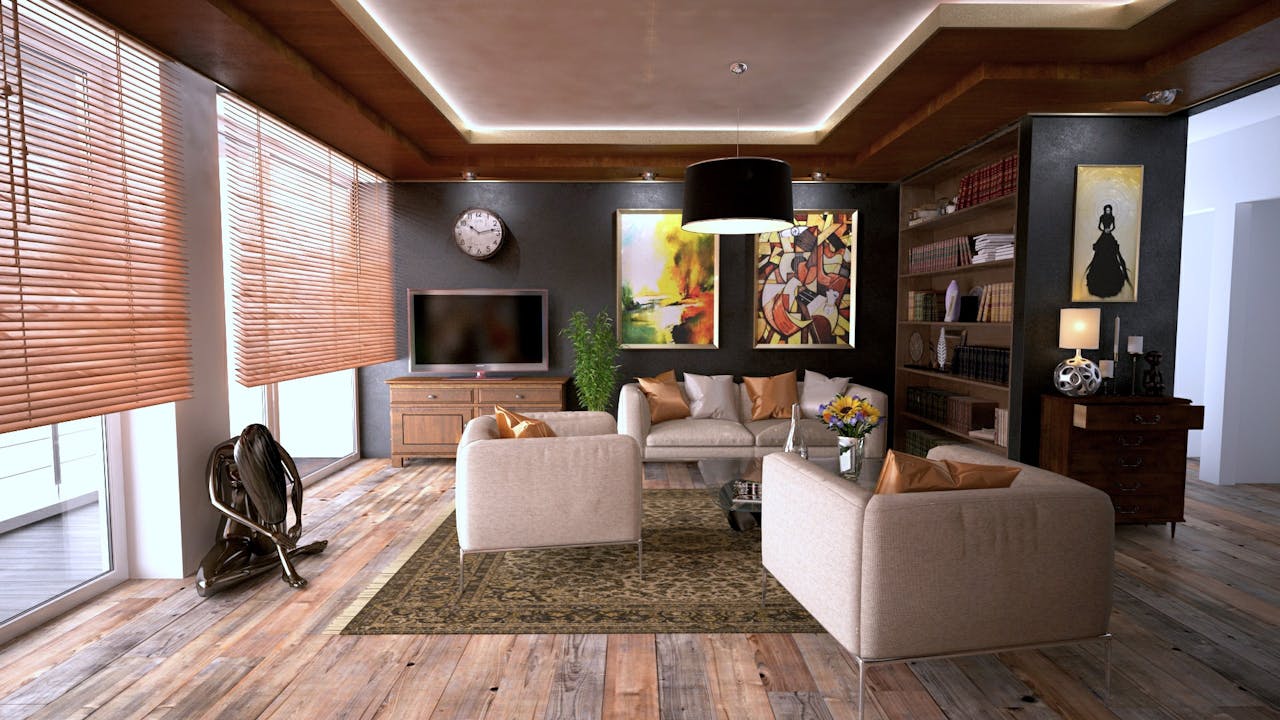Did you know the global interior design market is growing fast? This is because people want to make their homes their own. Understanding design styles is key to creating a unique and welcoming space.
We’ll dive into the changing world of interior design. We’ll look at both the latest trends and the classics. Knowing what each style offers can help make a space truly yours.
Key Takeaways
- Understanding various interior design styles can help homeowners personalize their spaces.
- The interior design market is evolving with new trends and classics.
- Choosing the right style can significantly impact the ambiance of a home.
- Personalizing a living space is a growing trend among homeowners.
- Different styles offer unique characteristics that can enhance a home’s aesthetic.
Introduction to Home Interior Styles
Exploring home interior design shows us that finding your personal style is crucial. It makes your space truly feel like home. Thanks to online interior design services, finding a professional who gets your vision is easier than before.
Home interior styles are more than looks; they’re about creating a space that shows who you are and meets your needs. Whether you love modern home designs or traditional styles, knowing the different interior design styles is the first step to making your house a home.
The variety of interior design styles can be a lot to take in. But by looking at different styles and picking what you like, you can start making a space that’s all yours.
Interior designers are key in this journey. They offer expert advice on bringing your style to life. With their guidance, you can explore the wide world of interior design and make a home that’s both stunning and practical.
Modern Interior Design
The modern interior design style is all about embracing the ‘less is more’ philosophy. It creates a sense of openness and clarity.
Modern interior design is different from contemporary design. It refers to a specific historical period. It’s known for clean lines, minimal ornamentation, and a focus on functionality. This style is popular for its sleek and sophisticated look.
Key Features of Modern Design
Some key features of modern interior design include:
- Open floor plans that make spaces feel bigger
- An emphasis on horizontal and vertical lines
- The use of industrial materials like steel and concrete
- A minimalist approach to decoration
- Large windows to let in natural light
As modern home designs evolve, these core elements stay central to the style’s identity.
Popular Color Palettes
Modern interior design often uses a neutral color palette. Shades of white, gray, and beige are popular. These colors create a clean backdrop for the space’s architectural features.
| Color | Shade | Usage |
|---|---|---|
| White | Pure White | Walls, Trim |
| Gray | Charcoal | Furniture, Accents |
| Beige | Soft Beige | Upholstery, Rugs |
Bold colors can be added through artwork or decorative accessories. They add personality to the space.
Furniture Selection Tips
When choosing furniture for a modern interior, look for clean lines, minimal ornamentation, and functionality. Pieces that serve multiple purposes are valued in modern design.
“The modern home is not just about aesthetics; it’s about creating a functional living space that adapts to our changing lifestyles.” –
By picking furniture that is stylish and functional, homeowners can create a space that follows contemporary interior ideas. It also meets their practical needs.
Traditional Interior Design
Traditional interior design brings classic elegance to your home. It draws from 18th and 19th-century European styles. These styles are known for their symmetry, rich colors, and classic shapes.
Characteristics of Traditional Styles
Traditional design uses classic furniture and ornate details. It also features a neutral color palette with rich accents. This style combines comfort and elegance, making your home warm and inviting.
Some key characteristics include:
- Symmetry and balance in furniture arrangement
- Rich, muted color schemes
- Ornate details such as carvings and moldings
- Classic furniture pieces with intricate designs
Common Materials Used
The choice of materials is key in traditional design. Common materials include:
| Material | Use in Traditional Design |
|---|---|
| Wood | Furniture, paneling, and flooring |
| Velvet and Silk | Upholstery and drapery |
| Marble and Granite | Fireplaces, countertops, and flooring |
How to Achieve a Cozy Atmosphere
To create a cozy atmosphere, layer textures and use warm lighting. Add plush rugs, soft throw blankets, and comfy seating. This makes your space feel welcoming.
Using warm, rich colors on walls helps too. Adding eclectic home design elements, like vintage pieces, adds character and personality. This makes your space truly special.
Contemporary Interior Design
Contemporary interior design is always changing. It takes bits from different times and makes them fit today’s trends and tech. It focuses on new ideas, creativity, and caring for the planet. This makes it a favorite for those wanting modern, unique homes.
This design style is great at mixing different looks. It creates a space that’s personal and up-to-date. We’ll look at the differences between modern and contemporary, how to use art and decor, and eco-friendly choices.
Differences Between Modern and Contemporary
Modern and contemporary design are often mixed up, but they’re not the same. Modern design is from the mid-20th century. It has clean lines, few decorations, and focuses on function. Contemporary design is more flexible, using today’s trends and tech.
Modern design is simple, while contemporary design is more varied. It might use bold colors and different decor pieces.
| Design Element | Modern Design | Contemporary Design |
|---|---|---|
| Lines and Shapes | Clean, geometric | Varied, often unconventional |
| Color Palette | Neutral, monochromatic | Bold, diverse |
| Décor | Minimal, functional | Eclectic, expressive |
Incorporating Art and Décor
Adding art and decor is key in contemporary design. It encourages unique pieces that show off the homeowner’s style. Choose items that look good and mean something to you.
“The role of art in contemporary interior design is not just to decorate, but to create an experience, to provoke thought, and to inspire.”
Here are some ways to add art and decor to your space:
- Use bold, eye-catching pieces
- Add natural elements like plants or stone
- Play with textures and materials for depth
Sustainable Choices for Contemporary Homes
Sustainability is important in contemporary design. People want to live greener. Using eco-friendly materials, energy-saving gadgets, and sustainable furniture helps.
Here are some green choices for homes:
- Choose furniture and decor made from recycled or reclaimed materials
- Use energy-saving lights and appliances
- Opt for sustainable flooring like bamboo or cork
By choosing sustainable options, homes can be stylish and eco-friendly.
Rustic Interior Design
Rustic interior design uses organic materials and neutral colors. It brings warmth and coziness to homes. It also celebrates natural elements.
This style focuses on creating a welcoming atmosphere. It uses natural materials like wood, stone, and brick. It’s perfect for those who want a simple yet inviting home.
Elements of Rustic Charm
Rustic design blends well with nature. Key elements include:
- Reclaimed or distressed wood for furniture and flooring
- Natural textiles such as wool, linen, and cotton
- Earth-toned color palettes that reflect the outdoors
- Decorative items made from natural materials like wicker and rattan
Interior design experts say, “Rustic design is not just about looks; it’s about warmth and comfort.”
“The use of natural materials and earthy tones helps to establish a connection to the natural world, making our homes feel more grounded and serene.”
Best Wood Finishes for Rustic Styles
Wood finishes are key in rustic interior design. The right finish can highlight the wood’s natural beauty. Popular finishes include:
| Finish Type | Description | Best Use |
|---|---|---|
| Distressed Finish | Gives wood a worn, aged look | Furniture, flooring |
| Reclaimed Finish | Uses wood from old buildings, adding character | Accent walls, furniture |
| Natural Oil Finish | Enhances the wood’s natural grain and color | Wooden decor, furniture |
Accessorizing with Nature
Adding natural elements is crucial in rustic design. We can use:
- Vintage or antique pieces that add character
- Plants and greenery to bring in a touch of nature
- Natural fiber rugs and woven baskets
- Stone or brick accent walls
By adding these elements, we create a cozy and inviting home. Rustic design is more than a style; it’s a way of life. It values simplicity, functionality, and nature’s beauty.
Industrial Interior Design
Industrial interior design focuses on raw materials and simple decor. It draws inspiration from old factories and warehouses. This style is now a hit in modern home designs.
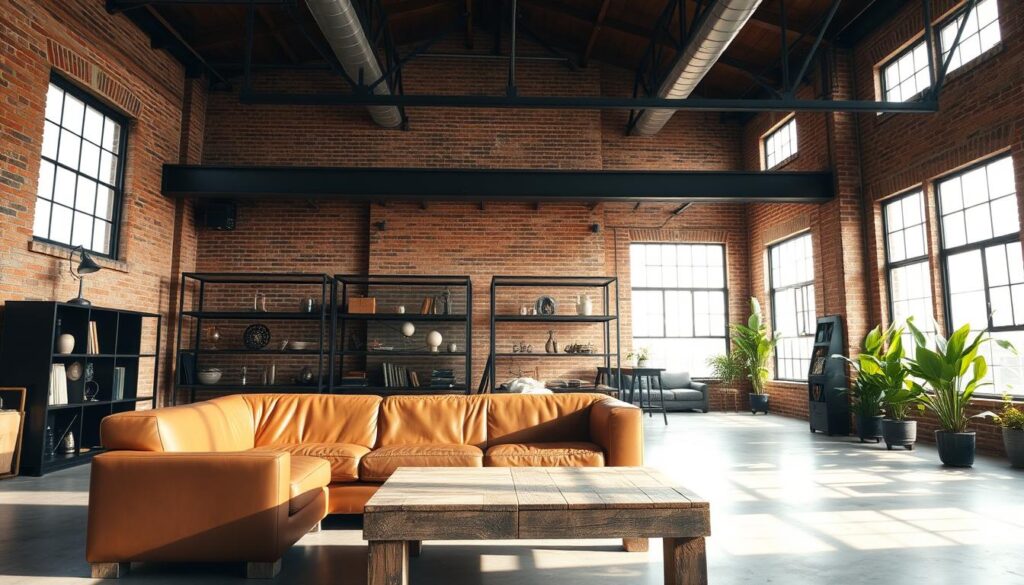
Origins of Industrial Design
Industrial design started with turning old industrial spaces into homes. These spaces, with exposed brick, metal beams, and concrete floors, set the style’s foundation. People started to love these elements and added them to new homes for a modern, rugged look.
Essential Furniture for an Industrial Look
To get the industrial vibe right, pick furniture that fits the raw look. Key items include:
- Metal-framed furniture, such as industrial-style beds and tables
- Reclaimed wood furniture, like wooden benches and coffee tables
- Leather sofas and armchairs, which add comfort to the industrial feel
Balancing Edginess with Comfort
Industrial design is bold, but it needs comfort to be livable. Soft textiles, like plush rugs and comfy upholstery, balance the industrial look. Adding plants and artwork also makes the space welcoming.
By mixing industrial’s ruggedness with modern comfort, you can create a unique house interior that shows off your style.
Scandinavian Interior Design
Scandinavian interior design is a mix of minimalism and warmth. It’s known for making spaces both beautiful and practical. This style has become popular around the world.
Scandinavian design focuses on simplicity, comfort, and nature. It’s more than looks; it’s a lifestyle that values sustainability and well-being.
Minimalist Philosophy
The core of Scandinavian minimalism is “less is more.” It encourages removing the unnecessary. This leads to clean lines and a clutter-free space. Minimalism brings calm and serenity to homes.
Key principles of minimalist philosophy include:
- Simplifying clutter and focusing on essential items
- Using natural materials and textures
- Embracing negative space
Color Schemes
Scandinavian spaces use calming colors like whites, creams, and wood tones. These colors reflect the Nordic landscape’s beauty. They also make spaces cozy and inviting.
A typical Scandinavian color scheme might include:
- Soft whites and creams as primary colors
- Earth tones such as beige and taupe
- Accents of muted greens or blues to bring in a touch of nature
Creating Cozy, Functional Areas
Scandinavian design balances function with coziness. It uses furniture, textiles, and lighting to make spaces inviting.
To create a cozy, functional area, consider the following:
| Element | Description | Tips |
|---|---|---|
| Furniture | Choose pieces that are both stylish and functional | Opt for multi-functional items like storage ottomans |
| Textiles | Use throw blankets, rugs, and pillows to add warmth and texture | Select materials that are soft and inviting |
| Lighting | Layer lighting to create a warm and welcoming atmosphere | Use a combination of overhead lighting, table lamps, and floor lamps |
By using these elements, you can make a Scandinavian-inspired space. It will be both beautiful and practical, showing off the best in contemporary interior ideas.
Coastal Interior Design
The coastal interior design style is all about lightness and natural elements. It brings the ocean’s freshness into your home, making it peaceful and welcoming. We’ll look at its main features, suggest fabrics for a beachy vibe, and share tips on using natural light.
Elements of Coastal Vibes
Coastal design often uses neutrals, whites, and beige, with blues and greens to match the sea and sky. We can add driftwood, jute, and linen to feel closer to nature. These materials connect us to the outdoors.
To make your home more eclectic, mix these natural materials with unique pieces that show your style. This mix creates unique house interiors that are both stylish and personal.
Best Fabrics for a Beachy Feel
Choosing the right fabrics is key for coastal design. Opt for lightweight, natural materials like linen and cotton. They’re breathable and keep the airy feel of coastal homes.
| Fabric | Characteristics | Use in Coastal Design |
|---|---|---|
| Linen | Lightweight, breathable, natural texture | Upholstery, curtains, bedding |
| Cotton | Soft, durable, easy to maintain | Slipcovers, throw pillows, rugs |
| Jute | Rugged, natural, earthy tone | Rugs, wall hangings, decorative accents |
How to Use Natural Light Effectively
Using natural light well is crucial in coastal design. Sheer curtains or blinds let sunlight in while keeping privacy. For more tips, check out Architectural Digest’s guide to coastal interior.
By following coastal interior design, we can make our homes feel like a peaceful seaside retreat. Whether you prefer an eclectic home design or a traditional coastal style, focus on bringing the outdoors in and using natural light and materials.
Bohemian Interior Design
Bohemian interior design is all about embracing freedom and creativity. It mixes different cultures and artistic styles. This makes it perfect for those who love to create unique spaces.
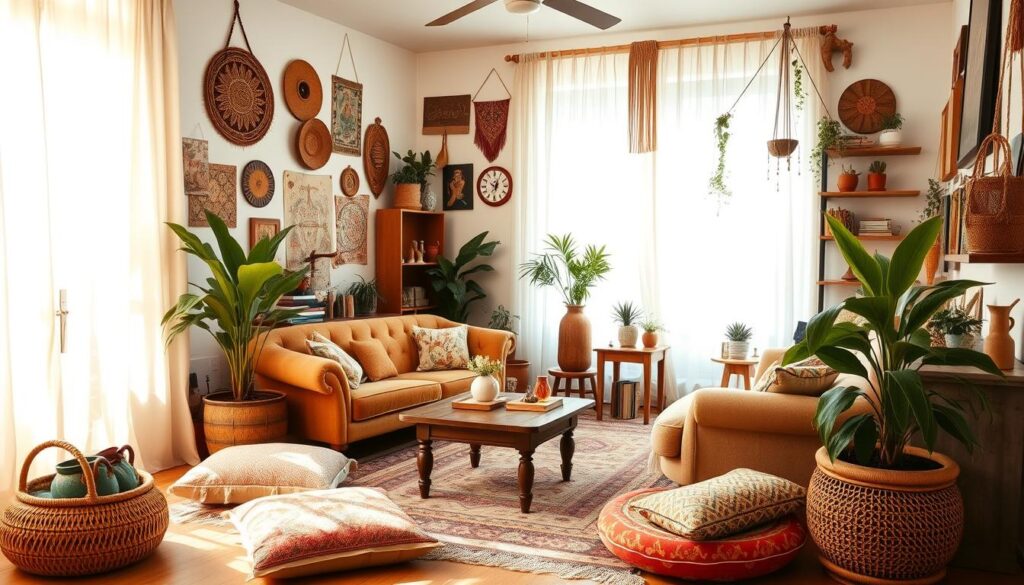
Embracing Color and Pattern
Bohemian design is known for its bold colors and patterns. Rich textures and vibrant hues make spaces lively. Use vintage rugs, colorful tapestries, and patterned fabrics to get this look.
Color-wise, bohemian design often blends earthy tones with bright colors. Terracotta, sage green, and turquoise are favorites. They add warmth and depth to any room.
Sourcing Unique Décor Pieces
Finding unique décor is key in bohemian design. Visit vintage shops, flea markets, and global markets for special items. These pieces should reflect your personality and style.
Adding handmade or artisanal items also boosts the bohemian vibe. Look for hand-carved wooden furniture, woven baskets, and handmade ceramics. They add character to your space.
Creating a Personal and Eclectic Space
To make a bohemian space truly yours, let your style shine. Mix different styles, eras, and cultures. This way, your space will feel uniquely yours.
- Combine vintage and modern pieces for a unique look.
- Use layered lighting to create a warm and inviting atmosphere.
- Incorporate plants and natural elements to bring life to your space.
By embracing the eclectic nature of bohemian design, you can make a space that’s both personal and beautiful.
Mid-Century Modern Interior Design
The mid-century modern style is known for its clean lines and functionality. It has greatly influenced interior design since the mid-20th century. This style focuses on blending indoor spaces with the outdoors, creating a smooth transition between nature and built environments.
Characteristics of Mid-Century Style
Mid-century modern design is marked by organic shapes, minimal ornamentation, and a focus on functionality. It often uses natural materials like wood, leather, and woven fibers. These add warmth and texture to any space.
- Clean lines and minimal decor
- Integration with nature through large windows and outdoor spaces
- Use of natural materials and textures
- Emphasis on functionality and simplicity
Iconic Furniture and Accessories
Mid-century modern design is famous for its iconic furniture pieces. Designers like Charles and Ray Eames, Eero Saarinen, and George Nelson created items that are both functional and beautiful.
| Furniture Piece | Designer | Description |
|---|---|---|
| Eames Lounge Chair | Charles and Ray Eames | A molded plywood and leather chair known for its comfort and style |
| Tulip Table | Eero Saarinen | A dining table with a cast aluminum base and a round or oval top |
| Nelson Bench | George Nelson | A wooden bench with a simple, minimalist design |
Blending with Other Styles
Mid-century modern design is very versatile. It can be mixed with other styles to create a unique space. For example, combining it with industrial elements adds an edgy contrast. Adding traditional pieces brings warmth and coziness.
“The key to blending styles is to find common ground among the different design elements, such as a shared color palette or texture.” – Interior Design Expert
Understanding mid-century modern design and how to mix it with other styles helps homeowners. They can create a stylish space that shows their personal taste.
Farmhouse Interior Design
Farmhouse interior design brings the feel of rural life into your home. It’s all about natural materials, vintage decor, and a cozy vibe.
Cozy Elements of Farmhouse Decor
Farmhouse interior design is all about coziness. To get this feel, we use:
- Plush textiles, like throw blankets and pillows, in natural fibers.
- Warm lighting, including table lamps and overhead fixtures with a rustic finish.
- Comforting colors, such as whites, creams, and soft pastels, which evoke a sense of calm.
Choosing the Right Hardware
Hardware is key to a room’s look. For a rustic interior design, we choose hardware with a vintage or distressed finish. This includes:
- Brass or bronze fixtures with an aged patina.
- Handles and knobs made from natural materials, like wood or stone.
- Decorative accents, such as antique door hardware, to add character.
Mixing Vintage and New
A great farmhouse interior design mixes old and new. We can:
- Pair antique furniture pieces with modern decor.
- Incorporate vintage accessories, like old signs or metalware, into our decor.
- Use new materials and finishes that mimic the look of aged or distressed surfaces.
This way, we create a space that’s both personal and welcoming.
Conclusion: Finding Your Perfect Home Style
Exploring interior design styles shows us there’s something for everyone. Knowing the different styles helps homeowners get the look they want. It makes their living space a true reflection of their personality.
Styles range from modern to rustic, each with its own flair. Recognizing these traits helps homeowners make smart choices in designing their homes.
We suggest trying out different styles to find what works best for you. Whether you love Scandinavian minimalism or bohemian eclecticism, there’s a style waiting for you.

